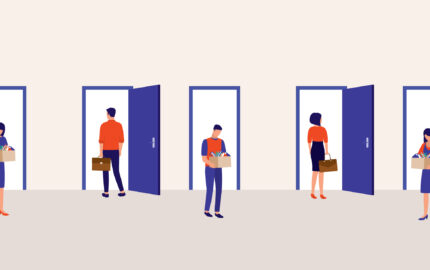When the Granite State News Collaborative launched in 2018, director Melanie Plenda hoped that she could find organizations to partner with.
“It was so new and such a new concept,” Plenda said, thinking back to the organization’s early days. “Collaboration, in general, is always good on paper, but the reality of it is you are having to trust people that you have been competitors with forever.”
The collaborative, based in New Hampshire, started out with just five members and has grown to more than 20 partner organizations including local media outlets, freelancers, universities, college papers, and non-partisan community groups.
The partners have shared Covid-19 stories, along with social and racial justice reporting and anything of statewide interest or impact with each other, and the shared stories can be published across all platforms.
“We're really better off working together, and it actually benefits the outlets in the long run,” Plenda said. “All of a sudden, it wasn't about competition, it was about ‘this is a great amount of information that we can get out to people.’”
Following our feature on newsroom collaborations by Stefanie Murray and collaborations between journalists and civil society organizations by Sarah Stonbely, we asked Nieman Reports readers for examples of collaborative journalism projects they’ve worked on and their impact. Readers shared that collaborations have helped with providing more resources to newsrooms, increased reporting, engaging new audiences, and achieving things no newsroom could do alone.
Collaborations can help newsrooms share resources
Collaborations across newsrooms allow for different partners to pool their resources to develop a project beyond what one newsroom could do on its own. In April, The Daily Northwestern and the Northwestern News Network, both student-run outlets at Northwestern University, collaborated to livestream the student government election debate. Because both outlets worked in different media — The Daily as a newspaper and NNN as a broadcasting network — each partner brought different skills to the table.
“Normally, the broadcast club at Northwestern [NNN] doesn’t get many views on their regular shows. The Daily Northwestern usually produces a few pieces every year about the election, but has never done a large-scale live debate,” wrote Alex Perry, The Daily’s product manager. “Putting the two together — NNN using The Daily’s historical knowledge of the subject and The Daily using NNN’s broadcast infrastructure — was what made the project launch properly.”
Collaborations like the live-streamed ASG presidential election debate hosted by @NNN_News & @thedailynu earlier this year >>> https://t.co/8rGBU1pGY2
— alex perry (@WhoIsAlexPerry) May 18, 2022
Along with expertise and infrastructure, newsrooms can also share sources amongst each other, says Jennifer Palmer of Oklahoma Watch, which teamed up with The Frontier to investigate Oklahoma’s spending of its Governor’s Emergency Education Relief funding:
“I had started reporting the story on my own but kept getting stuck. I had been working to gain the trust of a source, but he wasn't yet willing to give me all the documents he had access to. One afternoon he told me another reporter had been calling him, but he only wanted to work with me. But once I started collaborating with The Frontier, my source began feeding me more information, and the other reporters had additional sources. With three reporters, we were able to divvy up the work, bringing our own strengths to the project. We are both very small organizations so having the extra manpower helped progress the investigation much more quickly than if we had continued going it on our own.”
By combining source information, Oklahoma Watch and The Frontier discovered major discrepancies in the state’s education spending: Over $500,000 of the state’s $8 million Digital Wallet program, which provided grants to low-income families to buy school supplies during the pandemic, was used for purchases such as TVs, grills, home appliances, and gaming consoles, their investigation found.
Engaging new audiences
For many of the newsrooms that shared their projects with us, collaborations have allowed them to reach new and larger audiences. Floodlight News, a collaborative focused on environmental reporting that includes publications like the Guardian, The Intercept, and NPR, among others, saw over two million views across its partner stories. At Northwestern, interest in the student government election reached new peaks, with over 3,000 users tuning into the debate via Twitter, Facebook, and Instagram Live.
Collaborations not only produced larger audiences but more engaged ones as well. “Student groups hosted watch parties, and campus discourse during election week over group chats & social media was at an all-time high,” Northwestern’s Perry said.
In Spain, a collaboration between Barret Cooperativa, a small documentary production company, and the TV show Salvados helped revive public interest in a 2006 subway crash. Through a documentary titled “The Strategy of Silence” and a Salvados episode on the subway crash, many viewers began demanding justice for the victims, according to Barret Cooperativa’s Alex Badia.
Related Posts
“The starting point was a group of victims who had been [asking] for justice for six years with barely no repercussions. After our collaboration with a successful current affairs TV show [Salvados], [there was] a wave of social solidarity with the long-forgotten victims of the accident. It also bolstered the reopening of the criminal case, which led to the conviction of four metro company executives for 43 homicides,” Badia said.
Oklahoma Watch’s Jennifer Palmer described major legislative wins as a result of the collaboration with The Frontier: “The legislature called for a special concurrent session to oversee the state's spending of federal relief funds. Some said our reporting on this story, and others, led them to question the governor's oversight. Also, Democratic lawmakers called for the secretary of education to resign, though he hasn't.”
“None of the partner media could have completed the project alone”
Many of our respondents echoed one key sentiment: Their project could not have succeeded without the pooled resources, knowledge, and skills of each partner.
Chemical & Engineering News (C&EN), a weekly magazine by the American Chemical Society, joined forces with Paulette Vincent-Ruz, a researcher at the University of Pittsburgh, to better understand how chemists interact with each other on Twitter. Their project, titled “The Secret Silos of #ChemTwitter,” scoured more than 2,000 chemistry accounts on the platform and traced their relationships. Chemists on Twitter, the project found, tend to silo off by discipline, with few cross-talkers across the field.
Amanda Yarnell, Chemical & Engineering News“The project would not have been possible without each partner"
“The project would not have been possible without each partner,” Amanda Yarnell of C&EN wrote to Nieman Reports. “The academic partner offered critical data-analysis expertise not available in the newsroom, and the newsroom partner helped center chemists (the target audience) from the start, as well as providing critical data visualization and reach not available within the research institution.”
In Colorado, over 30 newsrooms participating in the Colorado News Collaborative (COLab) — a nonprofit journalism coalition comprised of over 170 publications including Colorado Public Radio, The Colorado Sun, and The Gazette (Colorado Springs and Denver) — investigated the state’s fraying public mental health safety net system in a series called “On Edge.” The various moving parts to the state’s mental health safety net made collaboration essential, noted Laura Frank, the executive director of COLab.
“The system is so complex — involving 18 state agencies and more than 75 programs — and mental health issues carry such a high stigma,” Frank wrote to Nieman Reports. With all its moving parts across dozens of organizations, “None of the partner media could have completed the project alone.”



